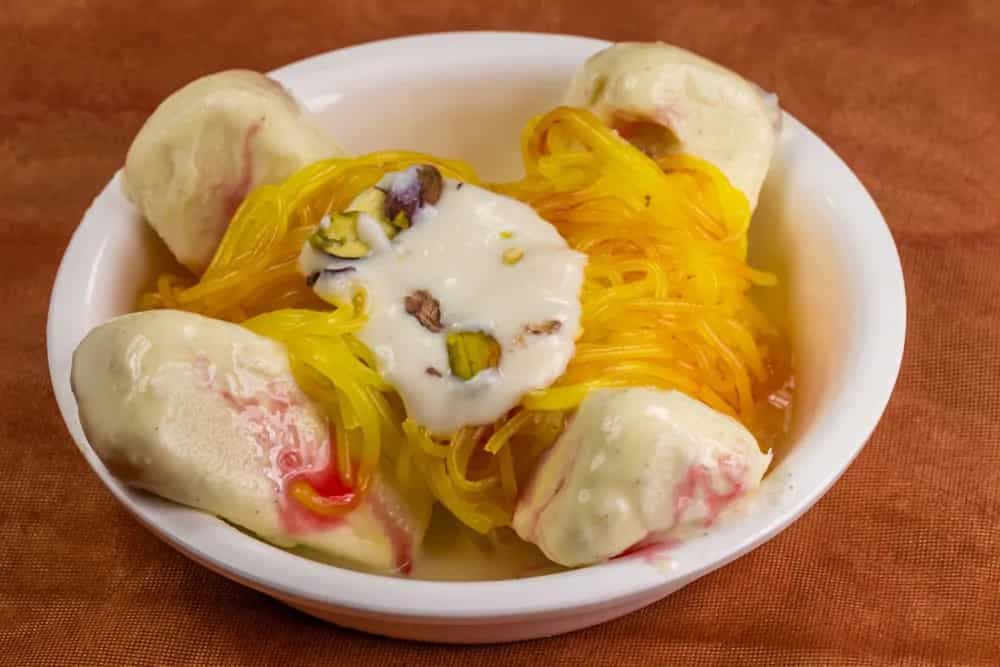Oh falooda! This delectable dessert holds so many precious childhood memories for people all over India. The feeling of waiting on the roadside stalls to get your kulfi with delicious falooda sprinkled on top is indescribable. With variants found all across West, Central, and South Asia, the biggest question arising here is: how did falooda become so famous? Well, to understand that, we first have to get into the origin and history of falooda.
Falooda is an Indian-Mughlai version of kulfi that is served with noodles. The origin of falooda dates back to Shiraz, Persia (currently Iran), where a similar dessert called faloodeh was well known. It is a standard Persian drink, enjoyed on "Jamshedi Navroze" by the Zoroastrian Iranis. This dessert made its way into Medieval India with the invasion of many dynasties (most famously the Mughals) who settled here in the 16th to 18th centuries. The present Indian form of falooda was developed during the Mughal Empire, particularly when King Nader Shah brought it with him when he came to India. However, many assert that falooda came trundling or cycling with the Iranians when they sailed to India. Of course, whichever way you look at it, this was a drink made especially for royalty.
Faloodeh was prepared by mixing rose syrup, vermicelli, and sweet basil seeds with milk and is usually served with ice cream. The vermicelli used to prepare falooda was made from wheat, corn starch, arrowroot, or sago. The Indian version consists of silky vermicelli noodles with ice cream or crushed ice, sprinkled with "tukmaria" (slithery black basil seeds), all of which is soaked in a colorful bath of rose syrup with sprinkled nuts as the final touch.

This dessert is now a major part of Indian cuisine, served at weddings and other occasions. The only main difference between the Indian falooda and the Persian faloodeh is that the latter consists of thin noodles made from starch or rice that are served with sorbet and drizzled with various syrups. It is crispy and has a textured crunch. Falooda, on the other hand, is boiled before serving and hence has a soft texture. It is almost always served in combination with kulfi.
Now for the million-dollar question: why do Indians enjoy falooda? Well, the answer is quite simple: Indians are all about their sweets! Desserts, in general, make our lives much more enjoyable and convenient. Hence, just the thought of a dessert like falooda that is so royal and luxurious is bound to make anyone’s mouth water. In fact, this dish is so widely popular that in Hindustani, the word "falooda" is used to describe something that has been shredded, which is an insinuation to the shredded vermicelli noodles. Thus, the expression "izzat ka falooda," which roughly translates to "my reputation is shot," came into existence.
A lesser-known fact is that falooda inspired many desserts all around the world. Even the current sensation, the Instagram-worthy bubble tea, which is a famous Taiwanese tea-based drink that is made of milk, fruit, fruit jellies, and tapioca balls, resembles falooda. A famous Thai-originated drink called Nam Manglak is also quite similar to falooda. It is a basil seed drink where the only difference is the use of tapioca pearls, shredded jelly, and tea grass flavoring with rose syrup. Another drink called Andrea is a variant of falooda made by combining creamy milk, premature tapioca pearls, and various rose syrups.
Overall, if we were to wax a bit poetic (as fans of the falooda, we should be allowed to!), we could say that this sumptuous sweet dessert escaped its gilded cage and made its way to culturally rich India, where it evolved into the cool, colorful dessert-drink that we all know and love today. I doubt any other country besides India could’ve embraced and respected this delicacy and made it one of its own, where it can be associated with our childhood smiles and our unforgettable family memories. Today, falooda is seen everywhere, from the hippest and chicest restaurants to roadside stalls.
It was William Shakespeare that wrote, "What’s in a name?" Well, he wasn’t wrong. Whether you call it Falooda or Faloodeh, we care less about the name of the desert, and much more about the taste. As long as it’s delicious and satisfies your sweet cravings, enjoy this royal dessert, whether it's in the comfort of your cozy home or outside on a roadside stall to beat the warm summer heat.


